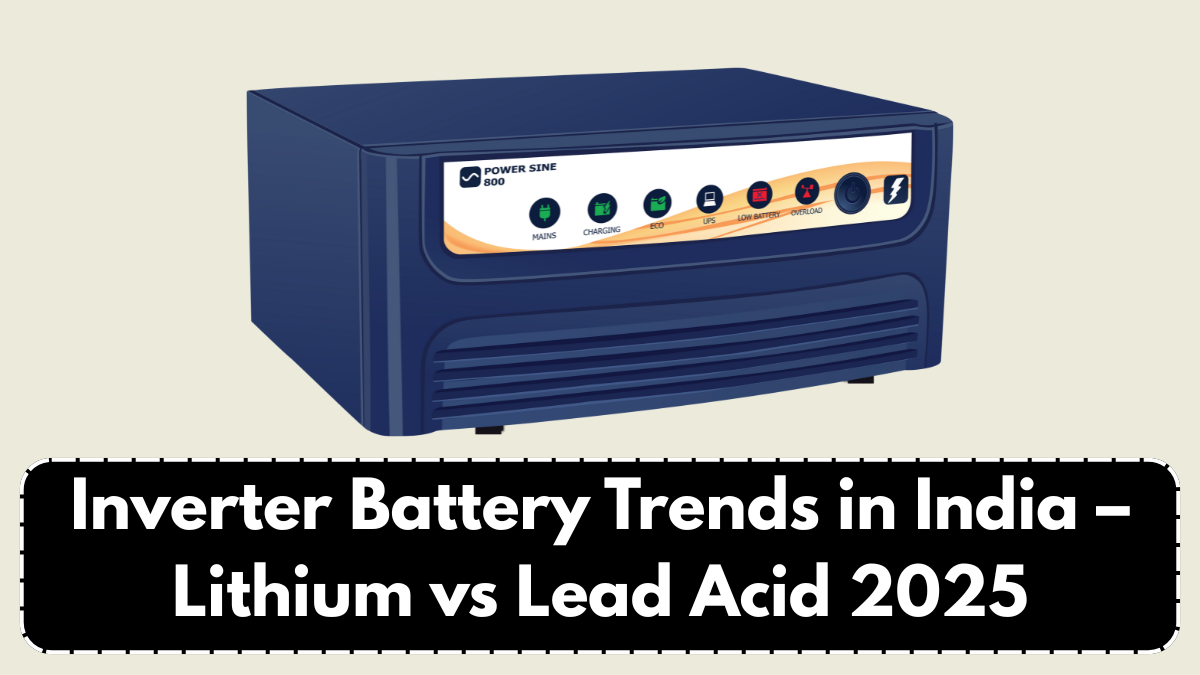India’s energy backup market is witnessing a technological shift, with inverter battery trends 2025 highlighting the growing preference for newer, more efficient solutions. As frequent power outages and increased energy demand persist, Indian households and businesses are actively upgrading their power backup systems. The choice between lithium vs lead acid batteries has now become central to this transition.
In 2025, advancements in inverter battery technologies have spurred changes in manufacturing, user preferences, and pricing. With government support for clean energy and consumer demand for durable and fast-charging solutions, the inverter battery sector is experiencing rapid transformation.

Market Overview and Shift Toward Lithium
One of the major inverter battery trends 2025 is the shift from traditional lead-acid batteries to lithium-ion options. While lead-acid batteries have long dominated the Indian market due to affordability and availability, lithium-ion technology is gaining momentum due to its extended lifespan and minimal maintenance.
Lithium vs lead acid debates have intensified as users weigh their long-term savings. Lithium batteries offer higher efficiency, compact size, and faster charging. On the other hand, lead-acid batteries are cheaper initially and have an established supply chain.
Key market factors include:
-
Rising urban demand for clean, reliable energy.
-
Solar inverter integration with lithium batteries.
-
Growing interest in smart battery monitoring systems.
Comparison: Lithium vs Lead Acid
Below is a table comparing lithium vs lead acid batteries across key performance indicators to help consumers make informed choices.
| Feature | Lithium-Ion Battery | Lead-Acid Battery |
|---|---|---|
| Lifespan | 7–10 years | 3–5 years |
| Maintenance | Minimal | Regular water topping needed |
| Charging Time | 2–4 hours | 8–10 hours |
| Weight | Lightweight | Heavy |
| Efficiency | 95%+ | Around 80% |
| Cost | Higher initial investment | Lower upfront cost |
| Eco-friendliness | Higher (recyclable, clean) | Lower (acid spills, lead content) |
| Ideal For | Urban homes, solar setups | Budget users, rural areas |
This detailed lithium vs lead acid comparison shows why many tech-savvy and urban consumers are moving toward lithium despite the higher price.
Emerging Trends in Battery Manufacturing
Inverter battery trends 2025 also reflect innovations in battery design and materials. Indian manufacturers are adopting international best practices to enhance safety and performance:
-
Smart battery systems: With embedded sensors and Bluetooth monitoring, users can now track battery health and charge in real time.
-
Eco-friendly materials: New research is enabling recyclable and non-toxic battery alternatives.
-
Hybrid battery packs: Some companies now offer hybrid models combining the benefits of both lithium and lead-acid technology.
Additionally, manufacturers are focusing on modular designs, making it easier for users to scale their backup needs.
Government Policies and Consumer Impact
The Indian government’s push for renewable energy is playing a key role in influencing inverter battery trends 2025. Incentives for solar power installations, GST reductions on lithium batteries, and MSME schemes for battery manufacturers are encouraging innovation and affordability.
Consumers now have better access to:
-
Subsidized battery systems under solar schemes.
-
EMI and exchange offers by major battery brands.
-
Warranties up to 7 years on premium lithium battery models.
This shift is not only changing how Indians choose backup power but also how they think about energy sustainability.
What to Expect Going Forward
Looking ahead, experts expect inverter battery trends 2025 to tilt more in favor of lithium, especially in metros and tier-1 cities. As costs decrease and technology becomes more widespread, lithium-ion is projected to lead the battery market within the next 2–3 years.
Key expectations:
-
More solar-inverter-lithium bundle packages.
-
Increased demand for IoT-enabled battery systems.
-
Better recycling programs for old lead-acid units.
Conclusion
The inverter battery trends 2025 are clearly heading toward smarter, cleaner, and more durable solutions. While lithium vs lead acid debates will continue for budget-conscious buyers, lithium’s benefits in efficiency, space-saving, and maintenance make it the future of inverter technology in India. With the government and industry both promoting innovation, consumers can now enjoy longer-lasting and more reliable power backup solutions than ever before.
FAQ
What are the key inverter battery trends in India for 2025?
In 2025, key trends include the rise of lithium-ion batteries, smart monitoring systems, hybrid models, and increased integration with solar inverters.
How does lithium compare to lead acid in inverter applications?
Lithium batteries offer faster charging, longer lifespan, and better efficiency, while lead-acid batteries are cheaper and widely available.
Are lithium batteries worth the higher cost?
Yes, they are worth it for users seeking low maintenance, long life, and integration with modern inverter systems.
Is the government offering any support for lithium inverter batteries?
Yes, schemes for solar integration and lower GST rates make lithium inverter batteries more affordable and accessible in India.
What battery type is better for rural homes?
For rural areas with budget limitations, lead-acid batteries may still be preferable due to their lower initial cost and easy availability.
Click here to know more